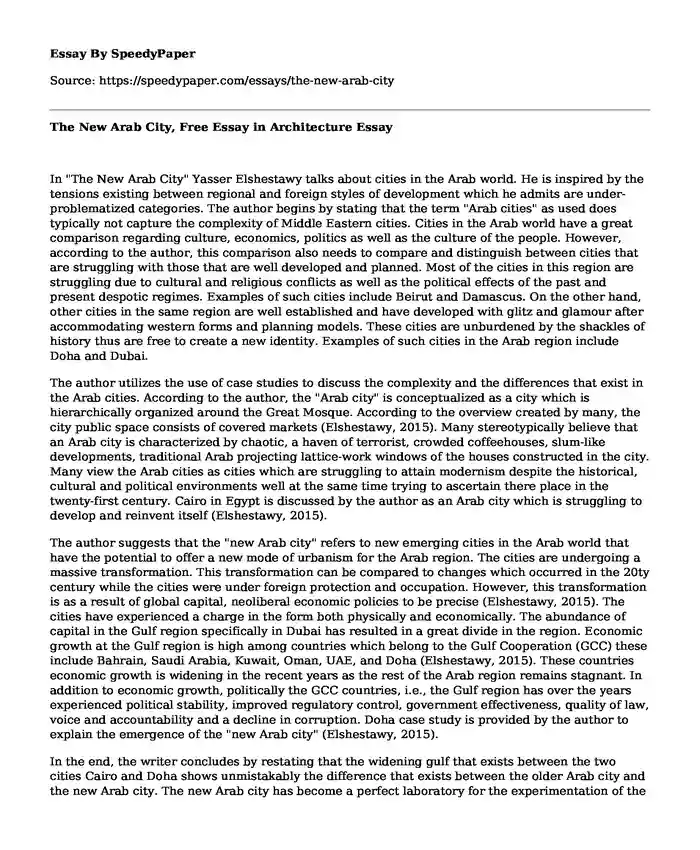
| Type of paper: | Course work |
| Categories: | Architecture |
| Pages: | 3 |
| Wordcount: | 647 words |
In "The New Arab City" Yasser Elshestawy talks about cities in the Arab world. He is inspired by the tensions existing between regional and foreign styles of development which he admits are under-problematized categories. The author begins by stating that the term "Arab cities" as used does typically not capture the complexity of Middle Eastern cities. Cities in the Arab world have a great comparison regarding culture, economics, politics as well as the culture of the people. However, according to the author, this comparison also needs to compare and distinguish between cities that are struggling with those that are well developed and planned. Most of the cities in this region are struggling due to cultural and religious conflicts as well as the political effects of the past and present despotic regimes. Examples of such cities include Beirut and Damascus. On the other hand, other cities in the same region are well established and have developed with glitz and glamour after accommodating western forms and planning models. These cities are unburdened by the shackles of history thus are free to create a new identity. Examples of such cities in the Arab region include Doha and Dubai.
The author utilizes the use of case studies to discuss the complexity and the differences that exist in the Arab cities. According to the author, the "Arab city" is conceptualized as a city which is hierarchically organized around the Great Mosque. According to the overview created by many, the city public space consists of covered markets (Elshestawy, 2015). Many stereotypically believe that an Arab city is characterized by chaotic, a haven of terrorist, crowded coffeehouses, slum-like developments, traditional Arab projecting lattice-work windows of the houses constructed in the city. Many view the Arab cities as cities which are struggling to attain modernism despite the historical, cultural and political environments well at the same time trying to ascertain there place in the twenty-first century. Cairo in Egypt is discussed by the author as an Arab city which is struggling to develop and reinvent itself (Elshestawy, 2015).
The author suggests that the "new Arab city" refers to new emerging cities in the Arab world that have the potential to offer a new mode of urbanism for the Arab region. The cities are undergoing a massive transformation. This transformation can be compared to changes which occurred in the 20ty century while the cities were under foreign protection and occupation. However, this transformation is as a result of global capital, neoliberal economic policies to be precise (Elshestawy, 2015). The cities have experienced a charge in the form both physically and economically. The abundance of capital in the Gulf region specifically in Dubai has resulted in a great divide in the region. Economic growth at the Gulf region is high among countries which belong to the Gulf Cooperation (GCC) these include Bahrain, Saudi Arabia, Kuwait, Oman, UAE, and Doha (Elshestawy, 2015). These countries economic growth is widening in the recent years as the rest of the Arab region remains stagnant. In addition to economic growth, politically the GCC countries, i.e., the Gulf region has over the years experienced political stability, improved regulatory control, government effectiveness, quality of law, voice and accountability and a decline in corruption. Doha case study is provided by the author to explain the emergence of the "new Arab city" (Elshestawy, 2015).
In the end, the writer concludes by restating that the widening gulf that exists between the two cities Cairo and Doha shows unmistakably the difference that exists between the older Arab city and the new Arab city. The new Arab city has become a perfect laboratory for the experimentation of the different forms of place formation and citizenship. The new Arab cities are categorized by a unique hybridized culture and populace, i.e., there exists both the western as well as the traditional Arab cultures.
Reference
Elshestawy, Y. (2015). The New arab City. The City Reader, 328.
Cite this page
The New Arab City, Free Essay in Architecture. (2022, Apr 25). Retrieved from https://speedypaper.net/essays/the-new-arab-city
Request Removal
If you are the original author of this essay and no longer wish to have it published on the SpeedyPaper website, please click below to request its removal:
- Thesis Paper Example: The Impact of Creditworthiness on Cash Management
- Business Essay Example on KPMG Management Consulting
- Free Essay on Sources of Finance for SMEs and Difficulties in Finance Raising
- Essay Sample: Affidavit for Search Warrant
- Essay Sample: Thomas Jefferson on the Reasons Why Slavery Existed
- Essay Example on the Failure of Yahoo China
- Free Essay Example: Uses of the Core Curriculum
Popular categories




